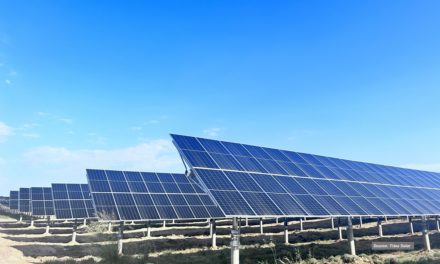- Albedo accuracy is pivotal for predicting a PV system’s bifacial gain, with snow and other materials showing variations of over 100%
- Research aims to optimize albedo with materials, positioning, and degradation considerations to enhance PV system performance
- Large utility-scale PV plants, especially in desert environments, experience significant albedo variations ranging from 29% to 41%
- Daily and seasonal changes in albedo, sometimes exceeding 60%, can impact PV system performance by 2% to 7%.
The overall increase of a bifacial PV system’s energy yield does not only depend on the modules’ bifaciality, several parameters such as site albedo, mounting configuration and the size of the system are also important inputs for bifacial gain.
Surface albedo
Albedo, or solar reflectivity, is simply the fraction of the incident sunlight that a surface reflects.
Albedo values range between 0 and 1. Value 0 means that the surface is a ‘perfect absorber’ and absorbs all incoming light like a ‘black body,’ while value 1 means that the surface is a ‘perfect reflector’ and reflects all incoming light like a ‘mirror.’ An albedo value of 0.4 means that the surface reflects 40% of the sunlight and absorbs 60% of the solar radiation. One might mistakenly think that the surface albedo is a simple value. The crux of the matter is that the albedo is not constant for a certain surface, but it depends on the wavelength and varies with the spectral and angular distribution of the sunlight. Thus, for the same surface, the value differs depending on sunny or cloudy days and on time of the day, season of the year and the PV plant’s latitude. Last but not least, each material shows unique spectral reflectivity; hence, changes according to ground vegetation, rainfall and snowfall as well as soiling have a strong impact on albedo.
Reflectance range: While albedo changes for every material depending on various factors such as water content and material graininess, it more or less falls into a range as depicted in the above table. (Source: SOLARGIS)
Accurate albedo values are needed to estimate the bifacial gain of a PV installation, which makes energy yield predictions quite complicated. Indeed, albedo is the most critical parameter for calculating the bifacial energy yield of a PV system. As shown in the table, the value can vary dramatically even for the same material, such as snow showing differences of over 100%. Stefano Latella et al. from Italy’s ENEL Green Power presented a poster titled New Approach to Define the Optimal Placement of Albedo Enhancing Materials to Optimize Bifacial Gains Considering Position, Length, Reflection Coefficient and Degradation at the 40th European Photovoltaic Solar Energy Conference (EU PVSEC) in Lisbon, Portugal. The poster discussed an approach to increase the value and reduce the uncertainty of natural ground albedo by installing albedo-enhancing materials. The authors explored various materials, their optimal positioning relative to the PV structure, length requirements, albedo coefficients, and degradation over time, all assessed in terms of bifacial gain and overall energy yield.
High variance: Albedo varies across different wavelengths of light for common materials, as shown in this graph. Snow and white sand have high albedo across the spectrum, making them ideal locations for bifacial solar power plants, especially in regions like the Middle East and Oceania. (Source: California Institute of Technology)
Especially large utility-scale PV plants covering areas of several million square meters cannot take an average albedo value for the whole plant over the year. According to a visual presentation titled Impact of Variations in Albedo and Sensor Positions on Accuracy of Modelled Effective Rear-Side Irradiance for a Multi Megawatt Bifacial PV Plant with Tracking from Marie Syre Wiig, et al. from IFE Norway presented at 40th EU PVSEC, the albedo variation within a multi-MW bifacial plant located in the desert has been 29% to 41% based on the different sand samples collected within the site. Not only that, but the fact that variations in albedo during consecutive days or within a day are higher than 60% has been documented in literature. Deviations between using constant albedo and measured values are approximately 2% to 7% of the PV system’s total performance, as quoted in a 2024 published journal paper from Eneko Ortega et al. of the University of the Basque Country. However, the surface albedo for a particular site can be determined either by on-site measurements, or by satellite remote sensing.
The text is an excerpt from the TaiyangNews Bifacial Solar Systems 2024 Report, which can be downloaded for free here.


















